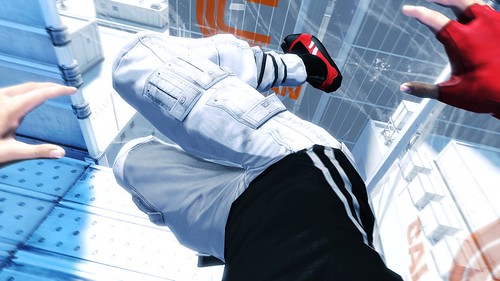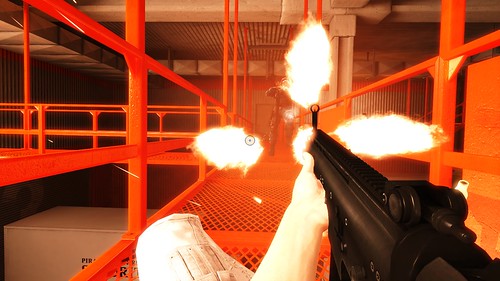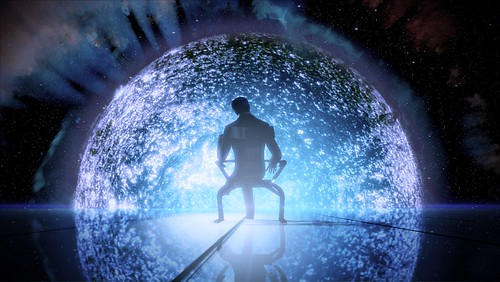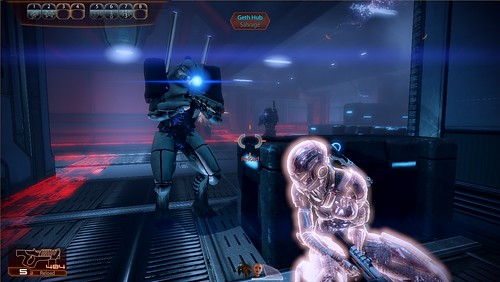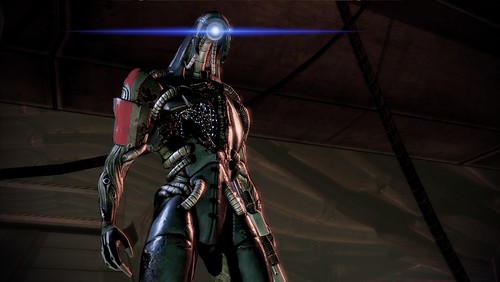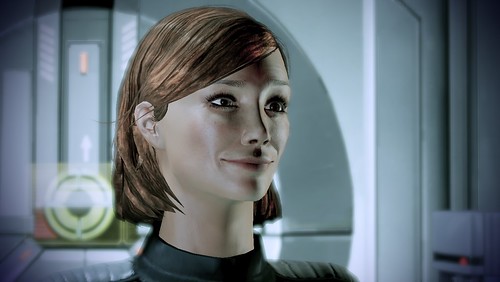TOM FRANCIS
REGRETS THIS ALREADY
Hello! I'm Tom. I'm a game designer, writer, and programmer on Gunpoint, Heat Signature, and Tactical Breach Wizards. Here's some more info on all the games I've worked on, here are the videos I make on YouTube, and here are two short stories I wrote for the Machine of Death collections.
Theme
By me. Uses Adaptive Images by Matt Wilcox.
Search

The Cove
Do you ever find yourself with a backlog of worthy, critically lauded films you’re almost certain you’d like but almost certain not to watch? Yes, I do, and I even worm my way out of the guilt for neglecting them. Because in my mental filing cabinet, they’re all under “Will watch”. It’s just that the films I’m actually going to watch aren’t in that file, they’re in the “Ooh, lasers!” one. Continued
The Cost Of Simplifying Conversations In Videogames
I was really entertained and inspired by this piece of satire, linked in an article by Chris Hecker, linked by Varanas on the Crate and Crowbar forums.
I started thinking out loud about it on Twitter, but didn’t want to swamp your timeline with it, so I’ll paste what I said so far and continue it here: Continued
The Completist: Tribes: Vengeance
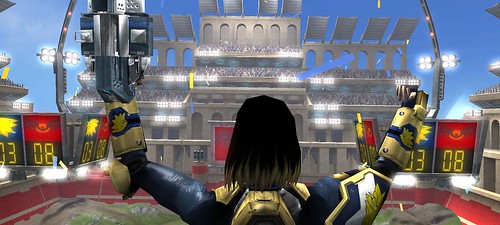
What I thought at the time: Great, but merely great. It got eighty-something in our mag (Tim reviewed), and I remember thinking “God, I love eighty percent games” as I jetted and ski’d around the enormous levels. The Grappling Hook level annoyed the living fuck out of me, though, to the extent that I stopped there and didn’t play it again for three years.
What the world thought at the time (paraphrased): The world was unavailable for comment since no-one in it actually bought Tribes: Vengeance. It went vritually unmarketed, so only the Tribes hardcore actually bought copies, which was kind of a shame because, by putting enormous effort into a lengthy, complex, story-driven single player campaign, it was very obviously designed to court everyone but the Tribes hardcore. They hated it.
What the world thinks now (paraphrased): The world is unavailable for comment as its populace have either a) never heard of it, b) forgotten about it entirely, or c) intentionally erased it from their memories to preserve their fondness for the original games.
What I think now: I liked it a lot more this time through, admittedly because I wasn’t above using a level skip cheat to avoid fiddling around with the dismal grappling hook level, and to retain my sanity when I lost yet another hour’s progress due to the COMPLETE FUCKING LACK OF AN AUTOSAVE. The ludicrous thing is, the reason I keep losing masses of my progress is that I like the game so much. I’m lost in it, so I’m almost never pulling back and thinking “This is a game, I need to save”.
It doesn’t even have a quicksave key. Instead, you have to pull out to a menu, select save, then select “New Save Game”, whereupon – I kid not – it asks if you want to overwrite “New Save Game”. It’s not really an option, it’s a dummy savegame they put in there that gets recreated when you save over it.
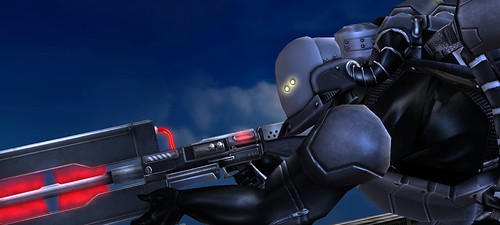
The thing I wish everyone would copy: Skiing! We have games with jetpacks – though not enough by anyone’s count – but we badly need more that combine your short-lived skyward thrusts with the ability to curl that gravitational potential round into blindingly fast lateral motion by angling your descent along inclines. It’s a thrilling, elegant and endlessly satisfying mechanic. Even on the last level I was amazed by the dizzying speed I could pick up by playing off the shape of the land.
Best bit: It’s partly that, but more specifically what that leads to in the context of a single-player shooter. Because the levels are enormogasmic, you have some time and distance to plan your attack. But the main thing you’re planning is not which weapon to use, where to throw a grenade, but the rollercoaster undulations of your blistering route through the area.
“If I jetpack over that ridge, I can land on the incline and ski all the way down to the facility, and hit that lip at the bottom to launch over that water-tower, take out the turret, and still have enough jetpack juice to blast up to the mountains on the other side of the valley to ski back for another pass.”
I got to the stage where I could execute all this without hitch almost instinctively, leaving my higher brain functions free to handle the shooting as I shot by. The centrepiece weapon is the Spinfuser, which is like a lightweight rocket launcher except that your missiles inherit your own velocity. That means that you have to lead to compensate for both your own movement and that of your target, so nailing five guys as you slide by at eighty miles per hour does genuinely need some brainwork.
I don’t think I’d like a game that forced you to conduct that kind of mathematics in the middle of an N-like momentum manipulation across a 3D landscape, but I love that there’s a game which lets me, and rewards me.
How cocking hard is it? Not too bad, but the challenge has its minor frustation factor magnified a billion times by the no-autosave thing. There’s the odd inordinately tough boss fight, some of them unexpected, and the prospect of repeating the entire preceeding level in order to take another whack at one of these caused me to level-skip to the victory cut-scene once or twice. I am not ashamed of this. Irrational should be.
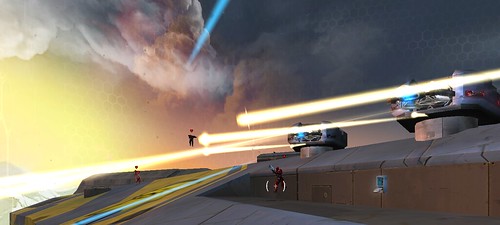
How long is it? Long. It feels super-epic, but in fact it’s merely long. It’s an utterly absurd structure – at various times you play a princess, her daughter at six, her daughter in her twenties, her daughter’s boyfriend, her daughter’s boyfriend’s killer and even your own killer. By the end of it, even though precious little of the dialogue and precious few of the characters have been even remotely good, you’re so exhausted by the sheer amount of plot you’ve lived through that you can’t help but feel rather satisfied.
Jumps the shark: Guess what? The grappling hook level. But not just because of the grappling hook. This is a level where you play a six year-old girl, piloting fighter jets and mowing down legions of trained soldiers. The problem with the grappling hook, by the way, is that their coders weren’t clever enough to work out how to make it wrap around obstacles that get in the way of the line, so when you grapple onto the ceiling or a high ledge, the challenge is to make sure your lifeline doesn’t brush some light fitting, skirting board or defect in the wall, or it will instantly vanish and you’ll plummet. It’s all the less tolerable because an Unreal Tournament player modded in a grappling hook with this feature implimented beautifully, and it took him all of a few afternoons. That’s the same engine.
What’s the end like? The penultimate level is really good, as mentioned, and entirely true to what made the bulk of the game great. The final one is a boss fight with someone who seemed to me to be a fairly minor character, and it’s pretty unremarkable. But it wins big points for a) not being at all frustrating, and b) being set above the clouds against a spectacularly beautiful sun. It’s one of the few games that ends in a place that feels like an appropriate place to end. It’s a game about flying, and you finish it higher than you’ve ever been before.
What’s the ending like? Surprising, actually. You never get to kill the real villain of the piece, she gets away scott free. It would almost be noir if the characters involved weren’t such hammy irritants.
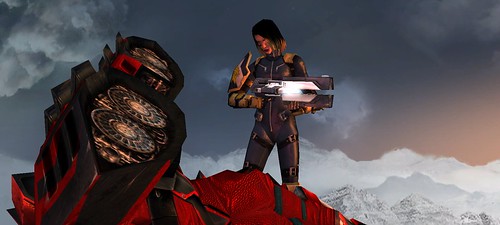
The Completist: Far Cry
Feh, I had another This Month in Terrible written but I’m bored of Terrible now. Terrible is over-rated. As stupid as it sounds, I’ve actually been reluctant to post here because I didn’t want to interrupt the series with something else, but didn’t feel like checking over and finding images for the final post. So, new series!
Valve’s stats show that still less than half their players have made it through the four-hour first episode of their follow-up to Half-Life 2. Crytek reckoned around 20% of gamers would see the end of Far Cry, and on anecdotal evidence I’d put the actual figure at less than half that.
If I really like something, though, I play it to death, then start again and play it back to life, and then really just mess around with its limp and compliant body of work until I get bored. So I shall, from time to time, note my thoughts on how old stuff holds up as I replay it, what the ending’s like, and how cocking hard it was. First up, Far Cry:

What I thought at the time: Brilliant! I knew the Trigen and indoor bits would suck, but I was expecting the game to degenerate into them for the whole second half, when in fact they turned out to be sprinkled bearably throughout. I remember playing River, one of the last few missions, about twenty times over, screwing it up each time but enjoying myself far too much to try and do it sensibly. I crashed boats into buildings, jeeps into the sea, boats into other boats, jeeps into boats, boats into people’s faces, and at one point a jeep into a helicopter. Sorry Bruce, I did it first.
What the world thought at the time (paraphrased): Brilliant! Unprecedented AI! Amazing graphicsability! Freeform gameplay! Ruined by Trigens!
What the world thinks now (paraphrased): Less brilliant! Everyone still loves the freeformness, but love for the AI has faded somewhat and the horrible Trigens and horribler last two levels have stuck in everyone’s minds.
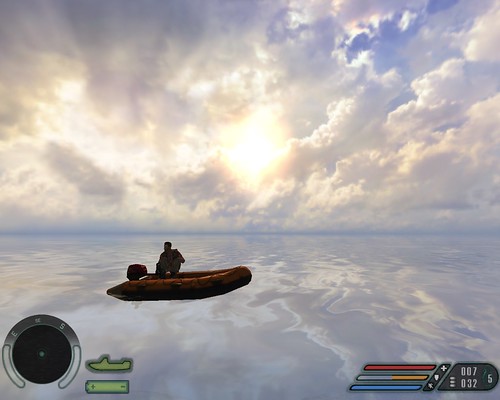
What I think now: More brilliant! I don’t know why, but the Trigens hardly bothered me this time through. I actually found them pretty scary – they pounce suddenly and unpredictably, and kill in one swipe, and take a lot of shooting, so you end up having a lot of moments where you only just kill them in time, causing them to fling their own limp, bullet-ridden bloody corpse into your face.
The two things that really stand up well today are the boats and the binoculars. Skimming that glossy rippled sea is pure joy, and crashing into a beach at a hundred and fifty miles per hour, flipping eighty foot into the air off a rock, is the only way to start a mission. At one point on Boat – a mission that has boats in it – I hit an enemy speedboat at full pelt, both of us firing, just as I took out their gunner. My boat hit the driver in the side of the head, threw me into the air, spun three times and landed the right way up in the water, just before I landed back in it and sped off. Bitches, I refer you to my wake.
The binoculars are The Thing I Wish Everyone Would Copy. In fact, new field:
The thing I wish everyone would copy: The binoculars. You scan an area with them and every enemy not behind anything very solid is highlighted, and their position is tracked on your radar from then on. It’s a level of intel most tactical shooters don’t dare give the player, for fear that he might be able to plan his attack, or enjoy himself. Situational awareness enables situational manipulation, and that’s where the fun always is.
Best bit: Oh, I wasn’t supposed to be talking about the best bits yet? Because that was the best bit.
How cocking hard is it? Not desperately, actually. Shameful admission: I actually played Far Cry on Easy mode the first time. I felt pretty smug about it, because everyone else was groaning about how hard it was even a third of the way through, and it gets a lot harder than that.
So I grit my teeth slightly when I committed to Medium this time through, but it was fine. I got through it without cheats and only mild frustration. I don’t think the end, which I’ll talk about in a minute, is as hard as people make out, it’s just frustrating. I died more times on the Boat level than on the last two missions put together, it’s just it wasn’t really my fault when I died on those, and I lost more progress.
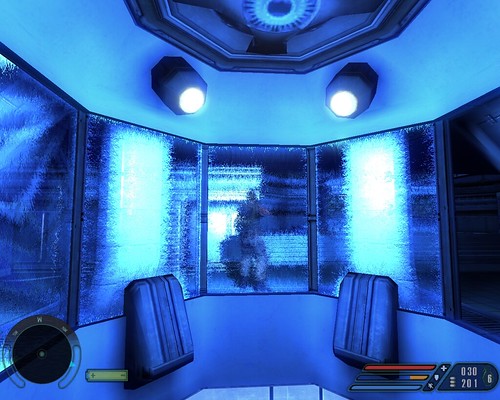
How long is it? Fairly. You could cut out all the indoor sections – around 30% of the game – and it’d still be a good game-length. You should probably do that. They’re not terrible, they’re just no better than most shooters.
Jumps the shark: Not right until the end, actually – the mission where you start with an M4 and ten bullets, and there are a million Trigens. That was dumb. I didn’t cheat, but I did install the quicksave mod. I foxed that first Trigen by waiting for him to pass a boulder on his way to me, and passing it myself on the other side. PSYCH!
At that point I jumped off the waterfall, on a motorbike.
What’s the end like? After that you’ve got a drive through instakill magma rivers with five hundred Big Trigens – WEAK – an assault on a large complex full of well-armoured commandos without much health or ammo – WEAK – the fight with Dr Krieger, who is tough and irritating and surrounded by lots of guys and there’s nowhere to hide – WEAKNESS ITSELF – then the infamous dust bowl of four hundred Big Trigens – NOT AS WEAK AS PEOPLE MAKE OUT BUT STILL PRETTY GODDAMN WEAK GUYS.
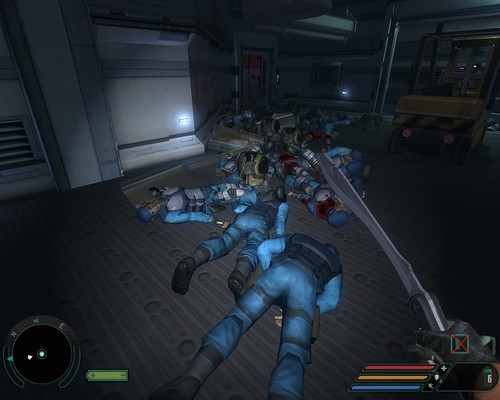
What’s the ending like? Abysmal.
Doyle: You don’t understand, Jack, they sent me, you can’t change the future!
Jack: Probably not! But I can make sure you’re not a part of it! LOL! (shoots Doyle)
Jack, that is totally changing the future you dick. Also stop talking like a barbecue salesman.
The Combat In Mirror’s Edge And Why It Fucking Sucks
Having played it through three times in English and once in Italian, it’s starting to look like I might be obsessed with Mirror’s Edge. This is my fifth post about it, and not my last. But even I think the combat is weirdly bad, and so easily fixable that you start to wonder what went on in DICE’s offices. There’s no way they had a roomful of testers play this and everyone said “Yep, seems fine.”
The three parts of it suck in different ways, and my proposed fixes are of equal obviosity.
Like Tuesdays, the melee combat in Mirror’s Edge has no feel. Despite loading-screen guff about run-ups giving your flying kicks more damage, every blow bounces off every enemy, triggering a fake ‘stagger’ animation. Nothing is physical, everything is the result of abstract rules.
If I, an unarmed action hero, manage to run at a firing gunman and flying-kick him in the face before he kills me, it has to knock him down. Look into your hearts, DICE, you know this to be true. It’s a fundamental axiom of awesome, like glass breaking when I dive through it. The same goes for slide-kicks to the groin, which should lift your victim momentarily from the ground as he’s propelled backwards onto his ass.
Punches should be weak, of course, which is precisely why there shouldn’t be any. You’re a slim woman with unprotected hands, it’s just not wise to hit someone wearing full body armour. If you’re sprinting when you collide with them, the impact should make them stagger. If you’re stationary, Attack should do the same as Disarm – recall that the Disarm button is actually the “Beat them up and disarm them” button.
Waiting for an enemy’s weapon to flash red during a specific frame of the same nonsensical shoulder-nudge they each perform is preposterous. I feel like I’m standing there as a favour to the game’s animators, because they only know how to show me grabbing a wrist in one particular position. It’s a terrible challenge, relying either on using slow-mo so slow that the wait becomes boring, or learning the animations by rote to anticipate the absurdly brief red flash.
Design tip! You’re supposed to hide – not force me to study – ridiculous conceits like canned animations.
Disarming should always work – slowly if they’re firing at you when you initiate it, quickly if they’re staggered or prone. Enemies shouldn’t try to nudge you with their weapons in close combat: you’re still in front of their gun, there’s no reason for them to stop firing. Instead they should start to run backwards as you approach, trying to keep you at a distance.
I love all the different words reviewers have found for this: loose, hollow, shaky, weak, fuzzy, bland. Obviously to make an unprecedented free-running game you can’t devote the time and budget it would take to make a really punchy shooter too. I wish DICE had seen the bright side of this, though: they didn’t have to! Shooting doesn’t have to take up the player’s time or be their source of fun. You can just have guns outright fucking kill people, the way they actually would.
Hitman’s the closest model of what I’m talking about: it doesn’t make a great shooter and it doesn’t have to. You spend most of your time in situations where you can’t viably open fire, so enemies don’t have to be tough and interesting challenges when you do. They can just die.
Once you’ve got hold of a gun in Mirror’s Edge, it should make a lot of noise, have a lot of kick, miss a lot at range, but kill when it hits.
If some of this sounds like it would make the combat too easy, that might be because I think the combat should be easy. But I also think it should be used in a completely different way, and I think I’m going to have to make that post number 6.
P.S. Graham’s blog Zeitgasm has also been redesigned, and is also harping on about Mirror’s Edge in tones I mostly agree with. 83% though, honestly.
The City That Rarely Enters Sleep Mode
I’m wrapping up this triplet of GTA posts with the one I should have started with: why it’s worth talking about in the first place. I can’t agree with its most frequent criticism – that it’s merely the same game tweaked – because none of the three things that keep bringing me back to it were present in any meaningful sense in its predecessors. Those would be:

Online
Right now I have raw ache in the back of my throat, from laughing. Earlier this evening Tim actually cried. It’s probably the fourth or fifth time three or more of us have piled into the Free Mode map – just GTA sans missions, optionally sans police, and plus de joueurs. And so far it seems like our vocal chords will wear thin before the game mode does.
The objective-based modes are fine, but they’re just fun missions in which you can also do ridiculous stuff. Free mode is based around our own objectives. They don’t have to be particularly well-conceived ones. Tim wanted to know if a bike could jump through the doors of a helicopter. Rob wanted to know how many of us – each with varying Wanted levels – could ride together in a bus. I wondered if we could accurately bail from maximum-altitude helicopters above Central Park and land safely in the lake.
No, all of us, and no. What we did discover was that a helicopter propellor will swat an airbourne moped far enough that, even after the laughter had died down, I was able to truthfully say “Guys, I still haven’t landed.” And that while a bus makes a forceful and hardy getaway vehicle, there’s only so long it can wait for me to fumble with its diabolical automatic door under a monsoon of gunfire and a barrage of unbraking black-and-whites before it really ought to get going. And that, on a breezy day, ensuring your helicopter is geostationary over a large body of water is no guarantee that you’ll land in it when you bail.

New York
Liberty City – this Liberty City – is faithful to New York on a level GTA has never tried before. As well as the structure and detail, it captures the character and subtlety of a real place that games struggle to make up.
New York is my favourite place, and having a digital replica lets me explore it in ways I couldn’t even if I lived there. I don’t like to call these things too soon, but I don’t think I’ll ever actually find myself superbiking through Times Square in a thousand dollar suit. I hope I’ll never have to snipe Union workers down by Pier 45. And though the urge to throw myself off the Empire State enters my mind every time I top it, I can’t imagine it would really be as fun as it was in GTA IV. Doing these things gives me a feel for New York I couldn’t get otherwise, even if I spent significantly more on a trip there than I did on this console. It’s a new, cheap, bloody form of holiday.
So Rockstar can’t take all the credit for its exquisite sense of place, looming scale, gently fading ambience, but we get the full effect. It’s a city you can almost smell. So many different parts of it are beautiful in so many different ways, at so many different times. The runway lights at Francis bleeding blindingly into the mist on a foggy morning, Central Park blushing amber at sundown, rain-slick midtown Manhattan festive with red brake lights reflected in the wet tarmac, Times Square mall-bright in the dead of night, and the lazy, immobilising heat buzzing off the cracked streets of Broker on a dazzling day.
Next to the majesty of the city they built to set it in, GTA’s actual game seems puerile and sad. You could write an epic in this place, it could have a force and resonance we’re not used to. Violence could mean something here, it could be shocking again, and provoke something from us. That’s partly why I can’t join the chorus praising Rockstar’s storytelling; an arbitrary variety-show of charicatures, taking turns to step up on a non-interactive stage to tell a meandering story so apparently slave to the episodic mission structure that it’s impossible to believe in. It’s not that it’s worse than a typical game story – nothing is – it’s just unworthy of this setting.
Police AI isn’t the next one. But if you watch my legs adjust to the bounce of the rowboat I’m crouching in, you can see – even through the abysmal video quality – a bit of Euphoria going on.
Euphoria
Traditionally, people in games are acting out pre-recorded animations until they’re killed, whereupon a simple mechanical physics system takes over to simulate how their limp body falls and how it reacts to what it hits on the way down. That means any time a game character collides with something his pre-defined animations didn’t account for, the developers have to decide whether he should fail to react to it at all, or die.
GTA IV is the first major game that can handle the in-between cases. It licenses a piece of witchcraft called Euphoria that can blend physical simulation in with set animations, so that whenever anything hits anyone, they’ll be knocked by it in a physically convincing way, react to it in a humanly convincing way, then return smoothly to one of their normal animations. I have no idea how it works.
Actually, I know almost exactly how it works – anyone who’s thought about this problem for a second since the birth of 3D gaming could tell you how the eventual solution would have to work. The mystery is how the hell it ended up running smoothly on a home console. It’s essentially having to simulate the musculature of the human body in real-time, plug that into a mechanical physiscs system and motion-captured animation, and then make it work on as many interacting bodies as you care to run down in one spree. On a system where some developers won’t use ragdoll because it’s too processor-intensive.
The upshot for the player is the most reactive game I’ve ever seen, and a proper milestone in the progress of game ‘feel’. Both of my other obsessions in this game – our suicidal crash-tests and the intense impression of existing within this city – draw their power from the physicality Euphoria lends to every interaction in the game.
Achievement unlocked: wrote about GTA IV for one thousand words without mentioning the phrases ‘American Dream’, ‘fresh off the boat’, or ‘living breathing city’.

The Calamitous Pacifist In Gunpoint
I’m trying to see if it’s possible to do this level without punching anyone. Not for the first time, my conclusion was: “Nope. Hmm, unless…”
I have to get to those stairs. The guard will shoot me if he sees me. I can’t open the building’s other entrance from the outside. Continued

The Bone Queen And The Frost Bishop: Playtesting Scavenger Chess In Plasticine
My chess variant stalled a while, cos I rarely felt like coding when my work day was done. So I bought a chess set and some plasticine to try some ideas lo-fi style. What follows is how my first game of this iteration of Scavenger Chess played out.
The Best Three Things On TV

Dexter: The new season is excruciatingly tense. It’s partly the suspense over how he can continue to get away with it when everyone seems to be closing in on him, but for me it’s also the maddening worry that they’re going soft, trying to humanise and redeem Dexter. In the end it’s a better show for continually threatening to do that without ever making good. I’ve never been so relieved to see a knife sunk into a helpless human torso.

Pushing Daisies: A light-hearted supernatural murder mystery about a pie-maker who can resurrect the dead – for one minute. The premise is gloriously fiddly: his touch brings the dead to life, but he has to kill the resurrectee with a second touch within a minute, or a random bystander will die in their place. The obvious application is asking people who murdered them, but they’re not always much help. The dialogue is sparklingly lyrical, the pace is refreshingly swift and the stars winningly chipper and likeable. And it has narration that doesn’t suck.

Damages: Has somehow stayed miraculously on the rails after a seemingly unfollowable pilot. A legal drama with a symmetrical cast of characters on either side, but where the divide between good and evil is ignored by all – especially the writers. Ted Danson makes such a compellingly sympathetic villain, and Glenn Close such a frighteningly ornery hero, that you end up riveted by the duel but unable to root for either side. The web of bizarre, volatile relationships between characters has the plot spasming wildly, untenably with episode. It seems to become more impossible to resolve with every step the two timelines take towards each other, but never cops out or undoes its awful machinations.

The Best And The Worst Of Mass Effect 2 (Spoiler Safe)
After playing about four hours a day for a week, I completed this yesterday.
Short review: fightin’s better, writin’s worse.
It’s a magnificent game, though, in so many ways. While playing, the things that nagged nagged so badly I had to write them out just for catharsis – it’s rather satisfying, it lets you stop analysing those problems and get on with enjoying the game. I’ve included those here in case it’s also cathartic to read them, but skip em if you’re just having fun.
I’ve also hidden anything that could be construed as a spoiler, with a link to reveal it that says what section of the game it’s a spoiler for.
First, one thing I wish I’d known before I started: You’re repeatedly warned that when you do the next main mission, there’s no turning back. This is a lie. Until you go to a thing called the Omega Relay and click ‘Enter’, you can still go back and do anything you like. Even after that point, some of the side-missions and personal quests willl still be available after you finish the game.
(No spoilers)
I think she’s now my favourite game character of all time. In ME1 it was a combination of a smart, take-charge protagonist role, Jennifer Hale’s naturalistic, commanding performance of it, and dialogue options that let me walk the line between ‘stern’ and ‘asshole’ with gratifying precision. In ME2, it’s all those things with the added pleasure that this is now my character. It turns out there’s a world of difference between sequels where you play ‘the’ character from the first game, and ones where you play your character from the first game. The face is my own creation and the voice is BioWare’s choice, but the two are now so powerfully linked that I’d squirm to watch someone else play as their Shepard.
(Spoilers about the first couple of hours – show)
(No spoilers)
Totally redoing the classes was a smart move: each now has a unique defining power that you use in virtually every fight, and it really made me excited to try them all. Biotic powers were always physical, but now they take effect instantly, making them practical and impactful to play with. And Tech has been beefed up to feel tactile too: freezing someone with Cryo ammo and shattering them with a punch is wonderfully satisfying.
I played Vanguard, whose special ability is a hilariously unwise ramming move that zaps you across the field to slam your opponent flying. I had some incredible moments where I’d smash someone out of the window with that, then shotgun their friend and punch their robot dog. If you go a similar route, make sure you do Grunt’s personal mission. Later you can learn one of your squadmate’s unlocked abilities, and Fortification works brilliantly with Charge.
(Major end-game spoilers – show)
Wow. I think it helps to play the last game immediately before this to get the full effect: I literally completed one and fired up the other. Even just the aiming is so much smoother, faster and more precise, and then when you fire: pow! It actually sounds like a physical object was launched from this weapon by an explosion! I didn’t dislike the weapons in the first game, but a combination of the excellent sound design, more forceful animation response, and robot dismemberment make this so much more tactile and fun. It feels like a few guys spent the whole of ME2’s development working on /feel/, and I think that’s something every sequel team should have.
(No spoilers)
The cover system is horrible. By making it the same button as Sprint, Use and Jump, you have to hide behind things before you can climb over them, you’ll stick to things you wanted to run past, and you’ll jump over things you wanted to hide behind. They still haven’t fixed the only real problem with ME1’s system: that when in cover, you’re not allowed to shoot anything to your sides or in front of you: you actually have situations where you have to take a few seconds to unstick yourself from cover, then walk back to where you were to be able to aim at someone directly in front of you. Two years they had, one fix to make, failed unaccountably they gone did.
Instead: they should have just had a sprint button. While holding it, you run as fast as possible and vault over anything in your way. When you’re not holding it, you’ll take cover behind anything you’re touching if you’re in combat. If you aim at anyone you can’t shoot because the game doesn’t have animations for it, you automatically come out of cover to turn to face them properly.
(Spoilers for both Mordin quests – show)
(No spoilers)
ME2’s substitute for ammo: all guns have infinite ammo, but they all need cooling, and the cooling tube thingy needs replacing every few shots. Luckily they all take the same cooling clips, so any you find restock your ammo for all weapons.
Firstly, this sounds like nonsense. Secondly, it actually is. It’s okay for the player to not really buy into the cooling concept, if it at least explains the ammo mechanic. But this concept is both unconvincing and an outright lie. That’s not how it works. You can run out of cooling clips for your pistol and still have 245 for your sub machinegun. There’s no way to use the pistol until you find more cooling clips for it: so weapons do have mututally exclusive clip types. Guys, that’s just ammo. Just call the pickup an ‘ammo box’ and we’ll get that it contains some ammo for each of your weapons. Don’t invent a bizarre new concept and then lie about the way it works.
And after all that, the system truly sucks. I’m constantly out of ammo for the one gun I like because I’m only allowed to hold 16 shots for it, and switching between that and the shitty pistol is a massive hassle. If I find some cooling tubes, I have to pick up one, then switch to the gun I like, then load it, then pick up the next one. Otherwise, it’ll fill the reserve ammo without filling the magazine, leaving me with even less ammo for the only weapon I like.
Instead: each weapon should have its own ammo, and that ammo reserve should be replenished automatically when you’re out of combat. Still encourages weapon variety, but you don’t have to search the whole goddamn room for clips, making sure you have the right weapon out, after every fight.
(Mild spoilers for recruiting Thane – show)
(Very mild spoilers about Harbinger – show)
(General spoilers about who Legion is – show)
(No spoilers, just the name)
Fails the first test of a name for any fictional character: use it in a sentence. “The Illusive Man is very impressed with your- heheh, no, I’m sorry, I can’t go on. The ILLUSIVE MAN? That’s what we’re calling him? In actual conversation?”
Instead: anything. I was vegetating in front of an episode of Friends the other day; Paul Rudd tried to come up with the worst name for himself imaginable, and settled on ‘Crapbag’. I would honest-to-God rather he was called that.
(Major spoilers about first Archangel encounter – show)
(Spoilers about returning characters – show)
(Spoilers for Thane’s personal mission and an interview – show)
(Intro spoilers – show)
Some actions now give you points for both. BioWare, let me explain the genius of your system to you so you can go back to using it correctly. ‘Paragon’ means doing something kind when it is not necessary. ‘Renegade’ means doing what may be necessary, even if it’s unkind. A person can be both: I punch and threaten people to make sure I get what I need quickly, but I’ll save lives if it doesn’t risk the mission. A single action can’t be, they’re defined as the complement of each other.
Worse, there’s now a skill that dramatically amplifies your Paragon and Renegade scores, completely defeating the point of the system. The game’s perception of your badassness and heroism is now based almost entirely on how many points you’ve pumped into a skill, and worse, it’s the same skill for both. If I wipe out a species because I don’t trust them (to take an example from the first game), that’s not more Renegade if I have +4 in Assault Training when I do it.
(No spoilers)
I did like landing on strange new worlds in the Mako and drivin’ around a bit, but inevitably they couldn’t make good on the promise of that Star Trek fantasy in ME1. ME2’s just a realisation of what they can do: concentrate on the worlds there’s a good reason to visit, and make them awesome. There’s nowhere as drab or awkward as Noveria in this game, and some of the main planets are downright exciting. Illium, in particular, is made real by the way the missions there take you in hovercars to cool places.
(No spoilers)
In theory I like the change: I hit the 150 item limit in Mass Effect 1, and sorting through the shit was made needlessly hard by a rubbish interface. Here there’s only one or two new weapons to find for each slot, and everyone gets them. They’re even meaningfully different: the second Heavy Pistol you get has less ammo but more damage per shot.
The trouble is, the new weapons are also so much better than the old ones that there’s no decision to make. The second Sniper Rifle fires around 3,000% faster than the original one, so if there is any difference in the damage per shot, it’s irrelevant. In the end the only decision you get to make is which Heavy Weapon to take, and they’re so cumbersome and ammo-starved that you end up avoiding them for most of the game.
It’s also a pain in the arse to switch between the good ones. It’s nice that they no longer make you carry all four weapon types, but as a Vanguard, I’m stuck with some useless toy called a Shuriken Pistol between my proper pistol and my shotgun, meaning I can’t weapon switch effectively without having to pause the game.
Instead: all that needs to change is for the newer weapons you find, which are a bit different functionally, to be similar in overall power to the old ones. If they just want to upgrade my Heavy Pistol damage, give me a Heavy Pistol damage upgrade – there’s a whole system for that.
(It’s exciting! That’s all I have to say – show pic)
(No spoilers)
 Okay Miranda, your previous ‘no smiling’ policy was working really well for me.
Okay Miranda, your previous ‘no smiling’ policy was working really well for me.
There’s no way to level up your squad or even see exactly what skills they have without leaving your ship with one of them and examining them planetside. And yet there’s a dedicated Squad screen on your personal terminal that would be perfect for it – instead, it’s functionless and missing most of the very information it’s there to provide.
To add weird problem to injury, every time you change area you have to re-select your squad and their equipment: even during the parts of the game when you have no choice of either.
Instead: assume I want to keep the squad members I selected when I left the Normandy, unless I turn back and try to leave the mission area: then, give me the option of aborting or switching squad.
(No spoilers)
The mini-game they’ve replaced the emptier exploration missions with really worked for me: the quivering line graphs gave a little thrill of excitement when they shook into a mountainous peak as I passed over a rich seam of Platinum. God damn you need a lot of Platinum in this game.
It does get old, but only shortly before you’ve got every upgrade you need. I think perhaps some late missions should give you a generous income of the main minerals so you can snap up anything you don’t already have.
(Spoilers for the prison – show)

The BAFTA Games Awards
I got to go to the BAFTA Games Awards, whenever it was that that happened! Feels like six months ago, but I think it’s about three weeks. Gunpoint was up for Best British Game (against GTA V and Tearaway – lol good luck) and Best Debut Game (against Gone Home and Stanley Parable – lol good luck), and it was nuts to see our game up on the giant screen during a black tie awards event. But mainly, it was just nuts to be at a black tie awards event. Here are some things that happened: Continued

The ‘Tiny World’ Game I Didn’t Make At The Weekend
Another Ludum Dare, the competition to make a game in a weekend! Another weekend I can’t really do so! Instead, I worked on Gunpoint. But as before, I’ll tell you what game I would have made. The theme was Tiny World, and my game idea is called… Launch Craft. Continued
That Band You Like Has A New Thing Coming Out
I’ve wanted a service like this for years: I tell it my favourite bands, it lets me know when they have a new album. I have far too many favourites, far too many of whom rarely release anything, to keep track of them manually, and too few people share my particular cross-section of interests to be comprehensive sources of information. I sometimes find out the third best band in the universe had a new album two years ago and no-one told me. Worse, I sometimes don’t.
Finally, there’s something a bit like that. I’d thought it would make a good Amazon feature – anything comes out by anyone I’ve rated highly or bought something by, mail me and you’ll probably get yourselves a sale. But it’s a Last.fm mashup that’s finally answered the call. This is great for me, Tom Francis, but possibly awkward for you, non-Last.fm user, because you can’t quickly make a Last.fm account and add a load of bands to it. The site insists that you use its Scrobbler in the background while you listen to your music normally, so it can spy on what you really listen to rather than taking your word for who your favourite bands are.
It’s called Soundamus, and it just generates an RSS feed of all new releases by all the artists you’ve listened to according to your Last.fm account. It’s actually slightly awkward for me too, because however much I love Buck Rogers, I don’t really care that Feeder have a new album. But on the other hand, this system is far more comprehensive than any that relied on me to remember who I like. The reason this is a problem that needs fixing in the first place is that I’m incapable of remembering that more than the last fifty bands I listened to even exist.
Here’s my Feeder-heavy feed, if you’re curious.
Testing, Wishlists, And A New Video
As promised on Twitter, I recently sent everyone on our mailing list instructions on how to get in on a new alpha test of Heat Signature. Keys went out to the first 2,000 people to do so, but I’ll also be keeping the testing list active and inviting people to future alphas from there, so you can still get on it now if you haven’t already. Clarification: this says you can still get on the list, not you can still get in on this alpha test. That test is over and there’s no date for the next one.
If you’re in the alpha: Continued
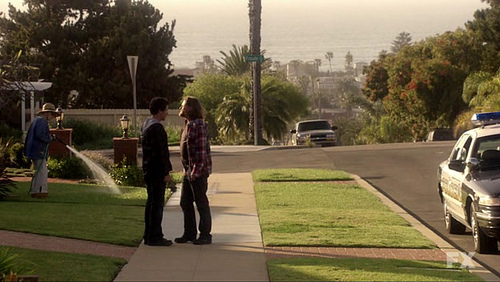
Terriers Again
I was pretty rude about the plot when writing about the pilot episode, but impressed by everything else. This is a quick update to say that, in the four episodes since then, that simple set up has changed dramatically every episode, and led to some superb twists and tense situations. Continued
